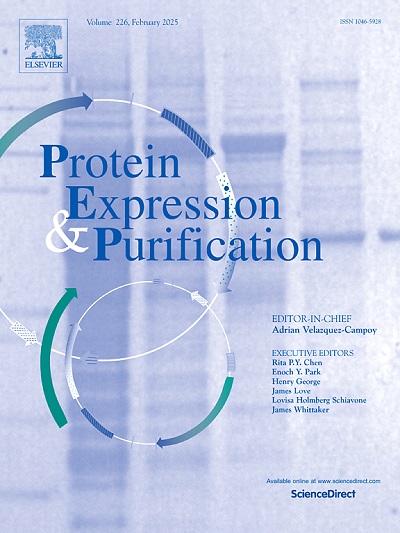D型产气荚膜梭菌Epsilon毒素在毕赤酵母中的表达及特性研究。
IF 1.2
4区 生物学
Q4 BIOCHEMICAL RESEARCH METHODS
引用次数: 0
摘要
Epsilon毒素(ETX)是继破伤风和肉毒杆菌神经毒素之后最强的梭菌毒素。ETX属于产气荚膜梭菌B型和D型产生的七聚体β-成孔蛋白,在家畜中造成致命的肠毒血症和重大的经济损失。ETX作为一种原蛋白被合成并被蛋白水解酶激活。由于诊断和治疗方面的局限性,通过疫苗接种和良好管理做法进行预防至关重要。市面上已有几种预防产气荚膜梭菌肠毒血症的疫苗。然而,工业生产是昂贵的,引起不同的免疫反应。这导致了对低毒性和提高效力的重组ETX亚单位疫苗的研究。本研究的目的是产生两个版本的重组毒素:截断的epsilon (rETX)和突变的epsilon (rETXH106P)。克隆并在毕赤酵母表达系统中表达,随后进行小规模培养和细胞毒性试验。实验证实两种重组多肽均无毒。随后调整大规模培养条件,以rETXH106P为重点,评价其动力学参数和潜在表达。这项工作表明,rETXH106P可能用于诊断试剂盒或作为亚单位候选疫苗,用于对抗肠毒血症和其他由ETX引起的疾病。本文章由计算机程序翻译,如有差异,请以英文原文为准。
Expression and characterization of recombinant epsilon toxin variants of Clostridium perfringens type D in Pichia pastoris
Epsilon toxin (ETX) is the most potent clostridial toxin after tetanus and botulinum neurotoxins. ETX belongs to the heptameric β-pore-forming proteins produced by Clostridium perfringens types B and D, which cause fatal enterotoxemia and significant economic losses in livestock. ETX is synthesized as a protoxin and activated by proteolytic enzymes. Due to limitations in diagnosis and treatment, prevention through vaccination and good management practices is essential. Several commercial vaccines exist for C. perfringens enterotoxemia prevention. However, industrial production is costly and elicits variable immune responses. This has led to the study of recombinant subunit vaccines of ETX with lower toxicity and improved efficacy. The purpose of this study was to produce two versions of the recombinant toxin: truncated epsilon (rETX) and mutated epsilon (rETXH106P). Both were cloned and expressed in a Pichia pastoris expression system, followed by small-scale cultivation and a cytotoxicity assay. The assays confirmed that both recombinant polypeptides were non-toxic. Large-scale cultivation conditions were subsequently adjusted to facilitate the evaluation of kinetic parameters and potential expression, focusing on rETXH106P. This work demonstrated that rETXH106P could potentially be used in a diagnostic kit or as a subunit vaccine candidate against enterotoxemia and other diseases caused by ETX.
求助全文
通过发布文献求助,成功后即可免费获取论文全文。
去求助
来源期刊

Protein expression and purification
生物-生化研究方法
CiteScore
3.70
自引率
6.20%
发文量
120
审稿时长
32 days
期刊介绍:
Protein Expression and Purification is an international journal providing a forum for the dissemination of new information on protein expression, extraction, purification, characterization, and/or applications using conventional biochemical and/or modern molecular biological approaches and methods, which are of broad interest to the field. The journal does not typically publish repetitive examples of protein expression and purification involving standard, well-established, methods. However, exceptions might include studies on important and/or difficult to express and/or purify proteins and/or studies that include extensive protein characterization, which provide new, previously unpublished information.
 求助内容:
求助内容: 应助结果提醒方式:
应助结果提醒方式:


